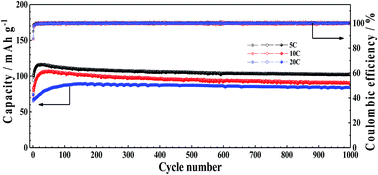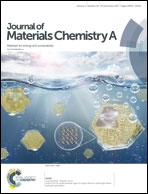Abstract
Organic composite electrode materials based on an aromatic polyimide (PI) and electron conductive polythiophene (PT) have been prepared by a facile in situ chemical oxidation polymerization method. The common aromatic structure possessed by both electroactive PI and electron conductive PT allows intimate contacts, resulting in conductive polymeric composites with highly reversible redox reactions and good structural stability. It has been demonstrated that the PI composite material with 30 wt% PT coating (PI30PT) has the optimal combination of good electronic conductivity and fast lithium reaction kinetics. The synergistic effect between PI and PT enables a high reversible capacity of 216.8 mA h g−1 at a current rate of C/10, as well as a high-rate cycling stability, that is, a high capacity of 89.6 mA h g−1 at a high current rate of 20C with a capacity retention of 94% after 1000 cycles. The elaborate combination of the high electronic conductivity of the PT coating and the fabulous redox reaction reversibility of the PI matrix offers an economic way to prepare high performance lithium ion batteries for sustainable energy storage applications.



 Please wait while we load your content...
Please wait while we load your content...